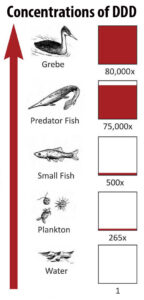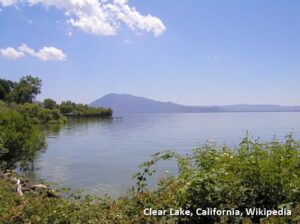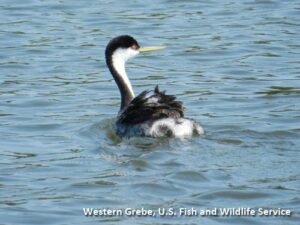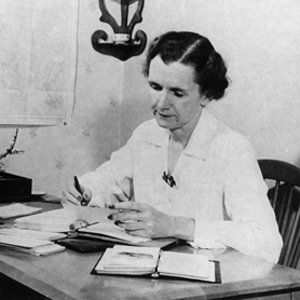October 26, 2022
Rachel Carson began Silent Spring’s Chapter 4, by stressing that surface water is society’s most precious natural resource.
She then traced the way fresh water can travel: falling to earth as rain, moving down through the soil to become groundwater where in time it can emerge, to serve our needs. She called groundwater,
“a dark subsurface sea…always on the move…[traveling] by unseen waterways until here and there it comes to the surface as a spring, or perhaps it is tapped to feed a well.”
Throughout Chapter 4, Carson pointed a finger at man’s apparent failure to sufficiently respect the value of our nation’s freshwater resources or consider the costs when users of toxic chemical pesticides were allowed to contaminate our nation’s waters. Even through in Carson’s day the human and ecological adverse effects defining hazards of the then popular chemical pesticides, were woefully lacking, the data that was available raised chilling questions leaving Rachel Carson no choice but to call for more and better protection of surface waters from further contamination by these widely used agents. She focused on reports of fish and migratory bird kills linked to certain chemical pesticides. She cautioned that people could be harmed by consuming fish contaminated with toxic chemical pesticides. Among the insecticides that Carson focused on in Chapter 4 were: Toxaphene, DDD, DDT and DDE.
Carson’s description of freshwater food chains began with:
“Water must be thought of in terms of the chains of life it supports…”
and followed by identifying relationships between microscopic plant-type, planktonic organisms at the lowest end of the water-based food chains up to the waterfowl as well as mammals including humans consuming fish at the highest levels of freshwater food chains. Carson noted that such food chains not only provide nourishment, but also the possibility of raising the body burdens of persistent toxic chemicals to dangerous concentrations especially in the bodies of animals feeding at the top level of aquatic food chains.
Such a contamination condition existed in California’s Clear Lake, due to the long-term adverse impact of the persistent insecticide, DDD on the Western grebe, year-round waterfowl residents of this aquatic community. It was described in Chapter 4 and is the second pesticide summarized below.
Specific Pesticide Problems Presented in Chapter 4
Toxaphene
The chemical insecticide, Toxaphene was so effective at controlling cotton pests that it had been widely applied. However, as Carson noted, it was also, so extremely hazardous to aquatic organisms that the runoff from Toxaphene-treated fields routinely killed resident fish populations in nearby rivers for up to a week after an application. Toxaphene was even used in efforts to eliminate certain unwanted fish from lakes and reservoirs. Toxaphene was on the market when Silent Spring appeared in 1962 and remained so for the next two decades, despite its disastrous effect on aquatic organisms and hazardous potential for people. (See Update, below for further information on Toxaphene)
DDD
DDD was involved in one of the most widely recognized incidents in Silent Spring. The case originated at Clear Lake, California. Rachel Carson described the process of biological magnification/bioaccumulation where there is an increase in the concentration of a chemically stable, persistent, fat soluble (hazardous) substance along a food chain.
 The chronicle of DDD’s adverse impact on California’s Clear Lake started when fishermen became annoyed by large numbers of gnats (not the biting kind). Since the gnats’ life cycle included an aquatic phase, the persistent, chlorinated hydrocarbon insecticide, DDD (related to DDT) was added to the lake water at very low concentrations to kill off the gnat’s larval forms developing there. Dr. Robert Rudd and Rachel Carson reported, that the DDD moved up the entire Clear Lake food chain from the initial low level in the water through the plankton (microscopic plant-like organisms), through the aquatic insects, through the small fish, feeding on the insects, through the predator fish that picked it up from smaller fish and concentrated it. Finally, DDD accumulated to dangerous levels in the fat tissues of the Western grebe, waterfowl residing and breeding at the lake. The Grebes’ diet consisted of predator fish at the higher levels of the Clear Lake food chain. No plausible findings for the deaths or for the failure to reproduce other than DDD were discovered by scientists who investigated the fatalities and reproductive failure of Western Grebes at Clear Lake. The concentration of DDD in the Grebe bodies was present at up to 80,000 times greater than the intended concentration in the lake water as a result of the 2nd and 3rd DDD treatments. Three lake water treatments with low levels of DDD took place over a span of nine years.
The chronicle of DDD’s adverse impact on California’s Clear Lake started when fishermen became annoyed by large numbers of gnats (not the biting kind). Since the gnats’ life cycle included an aquatic phase, the persistent, chlorinated hydrocarbon insecticide, DDD (related to DDT) was added to the lake water at very low concentrations to kill off the gnat’s larval forms developing there. Dr. Robert Rudd and Rachel Carson reported, that the DDD moved up the entire Clear Lake food chain from the initial low level in the water through the plankton (microscopic plant-like organisms), through the aquatic insects, through the small fish, feeding on the insects, through the predator fish that picked it up from smaller fish and concentrated it. Finally, DDD accumulated to dangerous levels in the fat tissues of the Western grebe, waterfowl residing and breeding at the lake. The Grebes’ diet consisted of predator fish at the higher levels of the Clear Lake food chain. No plausible findings for the deaths or for the failure to reproduce other than DDD were discovered by scientists who investigated the fatalities and reproductive failure of Western Grebes at Clear Lake. The concentration of DDD in the Grebe bodies was present at up to 80,000 times greater than the intended concentration in the lake water as a result of the 2nd and 3rd DDD treatments. Three lake water treatments with low levels of DDD took place over a span of nine years.
Addressing the Clear Lake findings, Rachel Carson wrote in Silent Spring:
“The nesting colonies of the grebes dwindled – from more than 1000 pairs before the first [DDD] insecticide treatment to about 30 pairs in 1960…No young grebes have been observed on the lake since the last DDD application [in 1957].”
“No trace of DDD could be found in the [Clear Lake] water shortly after the last application of the chemical. But the poison had not really left the lake; it had merely gone into the fabric of life the lake supports.”
“The fact that the insecticide was applied in very low concentrations is meaningless, as its explosive progress through the natural food chain… demonstrates.”
“What could a heavy dose of DDD, or perhaps repeated doses, do to…the human being who, caught a string of fish from the waters of Clear Lake?”
“The [Clear Lake] problem was resolved in favor of those annoyed by gnats, and at the expense of an unstated, and probably not even clearly understood, risk to all who took food or water from the lake.”
“DDD does strongly suppress the function of the human adrenal cortex…Its cell-destroying capacity is utilized in treatment of… a cancer… in the adrenal gland.”
RCLA Updates For Our Chapter 4 Discussion Based on Information Available After Silent Spring’s 1962 Publication
 Alternative Gnat Control for Clear Lake
Alternative Gnat Control for Clear Lake
DDD was no longer used in Clear Lake after 1959. The Inland silverside minnow (a small fish), was introduced to the lake in 1967 as a biological control agent for the Clear Lake gnat. As of 2018 the silverside minnow population was reported as thriving in Clear Lake. Recent reports from Clear Lake do not describe gnats as a problem for visitors.
Updates on Chemical Insecticides Mentioned in Chapter 4
1) Toxaphene Update
Toxaphene, a persistent, cyclodiene, chlorinated hydrocarbon chemical insecticide has been found highly dangerous to: fish, amphibians, crustaceans, molluscs and aquatic insects. It has been linked to cancer, as well as to nerve, liver, kidney, adrenal and blood damage in mammals (S. Briggs & RCC, Basic Guide to Pesticides, 1992). “For several years this insecticide ranked first in quantity used in the United States…” (p. 549, Cassarett and Doull’s Toxicology, 3rd edition, 1986). Toxaphene was even employed to eliminate unwanted fish populations from certain lakes. The USEPA required that labeling for Toxaphene-containing products must carry the signal word “Warning”– indicating the second highest category of hazard to human health. (Crop Protection Handbook 2012, p. 687). All USA Toxaphene products were cancelled in 1982.
2) DDD Update
It was cancelled in the USA in 1971 (S. Briggs & RCC, Basic Guide to Pesticides, 1992.
3) DDT Update
Virtually all US registered applications of DDT were cancelled in the USA in 1972 (S. Briggs & RCC, Basic Guide to Pesticides, 1992). However, USA manufacturing was permitted for DDT products being shipped abroad until 2001, at which time DDT was banned for agricultural uses worldwide under the Stockholm Convention on Persistent Organic Pollutants. Per that agreement, however, DDT is still permitted for use in countries that need it such as for malaria control (Berry, B., Banning DDT: How Citizen Activists in Wisconsin Led the Way, 2014).
DDT Found in Marine and Freshwater Sites (1980-2015)
In the Southern California bight at 300 feet below the surface, near the Channel Islands (off the California coast) as recently as 2021 scientists have been documenting barrels with 1-2% DDT dumped earlier by the Montrose Chemical Company (one time DDT producer). It has been estimated that hundreds of tons of DDT could be leaching from the barrels, accumulating in fish and in the wild sea lion population living near the dump site. There is “a massive epidemic of cancer in California sea lions… 1 in 5 of the sea lions has urogenital carcinoma” (Conis, E., How to Sell a Poison: The Rise Fall and Toxic Return of DDT, 2022, p. 323-324). Note: DDT was classified as probably carcinogenic to humans (Group 2A) by The International Agency for Research on Cancer (IARC) in 2015 (Press Release #236, IARC).
 Bald eagles in the Channel Islands have been reported as laying eggs with shells that are too thin “that broke well before they [eagle chicks] could hatch.” (Conis, E., How to Sell a Poison: The Rise Fall and Toxic Return of DDT, 2022, p. 323-324). Note: Egg-shell thinning was linked to DDT poisoning of Bald eagles and other birds of prey as deriving from consumption of contaminated fish — through the work of Patuxent Reseach Refuge scientists Lucille and William Stickel during the 1960s. (Graham, F., Since Silent Spring, 1970)
Bald eagles in the Channel Islands have been reported as laying eggs with shells that are too thin “that broke well before they [eagle chicks] could hatch.” (Conis, E., How to Sell a Poison: The Rise Fall and Toxic Return of DDT, 2022, p. 323-324). Note: Egg-shell thinning was linked to DDT poisoning of Bald eagles and other birds of prey as deriving from consumption of contaminated fish — through the work of Patuxent Reseach Refuge scientists Lucille and William Stickel during the 1960s. (Graham, F., Since Silent Spring, 1970)
In Alabama, DDT (and PCBs) have been found in fish in the vicinity of the Redstone Arsenal. Residents of the area consuming fish from local sources were found to have high body levels of DDT into the late 1980s. In a cleanup action ordered by EPA, 379 tons of DDT were removed from the Tennessee River’s tributaries. (Conis, E., How to Sell a Poison: The Rise Fall and Toxic Return of DDT, 2022, p.247)
Conclusions
As Professor Robert Rudd wrote: “Efforts to control a gnat with DDD led to nearly total contamination of fish flesh and the loss of most nesting western grebes on [Clear Lake]. This biological story…borders on the unbelievable…” (“The Chemical Countryside: A view of Rachel Carson’s Silent Spring,” Pacific Discovery, Nov-Dec 1962).
 The DDD concentrations in Grebes’ fat tissues measured up to 80,000 times higher than the water concentrations of the 2nd and 3rd of a total of three DDD treatments over nine years intended to kill only the immature gnats in Clear Lake.
The DDD concentrations in Grebes’ fat tissues measured up to 80,000 times higher than the water concentrations of the 2nd and 3rd of a total of three DDD treatments over nine years intended to kill only the immature gnats in Clear Lake.
More recently, as noted in our Updates section, above, underwater sites generating chemical pesticide residues in aquatic food sources have been linked to adverse effects found in birds and mammals. These findings “that border on the unbelievable” are among the problems confronting present and future generations.
Rachel Carson noted that after the disastrous reduction of Clear Lake”s Grebe population was reported: “In 1959 the California Department of Public Health required that the use of DDD in the lake be stopped… Although it professed to see no hazard.” Perhaps reluctance of the regulators to point the finger at DDD as responsible for adverse effects on the Western Grebes indicated the power at that time of commercial interests to silence criticism of chemical pesticides. Toxic damage from persistent, fat soluble, chlorinated hydrocarbons continues to challenge regulators even decades after these agents were intended to have been removed from our environment with the stroke of a pen.
Rachel Carson included information about the insecticide DDD’s potential to decrease the activity of the adrenal gland’s cortex indicating her concern for long term hazards to humans who might regularly consume DDD-contaminated fish. Damage to the adrenal gland where cortisol is produced can result in the syndrome known as Addison’s Disease. President Kennedy was reported to have been treated for this serious condition during his time in the White House. (Dallek, Robert, “The Medical Ordeals of JFK,” Atlantic Monthly, Dec. 2002) Kennedy spoke out against pesticide abuses and appointed his President’s Science Advisory Committee (PSAC) to review Silent Spring. The report of this Committee, released May 15, 1963 endorsed Carson’s conclusions and went even further in its famous “Recommendation Five” that stated: “Elimination of the use of persistent toxic pesticides should be the goal.” President Kennedy was aware of the support by his PSAC for Silent Spring before his tragic assassination on November 22, 1963. However, it is possible that the scientists endorsing Recommendation Five as well as President Kennedy himself could not have imagined how difficult it would be to eliminate from our environment significant amounts of “persistent toxic pesticides” decades after they were banned.
Protecting the planet’s wildlife and helping to conserve nature’s ecosystem services for future generations are among the reasons for all of us today to eliminate the use of as many chemical pesticides as much and as soon as possible. At the same time we need to call for significantly greater use of alternative, nature-based methods in agriculture, horticulture and forestry.
Diana Post, President with RCLA Colleagues and Staff (10-26-22)
Self-Testing Questions from Chapter 4: “Surface Waters and Underground Seas”
- What insecticide used on cotton plants was also highly toxic to fish? In what year was it banned by the USEPA?
- What was the reason for treating the water of Clear Lake, California with DDD?
-
How much greater was the concentration of DDD in the fat tissues of the Western Grebes than that which had been added to the water in Clear Lake, California to kill the immature gnats?
-
What condition was associated with DDD that reduced the cortex of the human adrenal gland and was the same as the one that President Kennedy suffered from?


